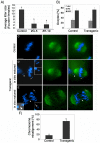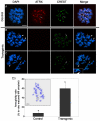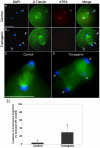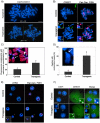Loss of maternal ATRX results in centromere instability and aneuploidy in the mammalian oocyte and pre-implantation embryo
- PMID: 20885787
- PMCID: PMC2944790
- DOI: 10.1371/journal.pgen.1001137
Loss of maternal ATRX results in centromere instability and aneuploidy in the mammalian oocyte and pre-implantation embryo
Abstract
The α-thalassemia/mental retardation X-linked protein (ATRX) is a chromatin-remodeling factor known to regulate DNA methylation at repetitive sequences of the human genome. We have previously demonstrated that ATRX binds to pericentric heterochromatin domains in mouse oocytes at the metaphase II stage where it is involved in mediating chromosome alignment at the meiotic spindle. However, the role of ATRX in the functional differentiation of chromatin structure during meiosis is not known. To test ATRX function in the germ line, we developed an oocyte-specific transgenic RNAi knockdown mouse model. Our results demonstrate that ATRX is required for heterochromatin formation and maintenance of chromosome stability during meiosis. During prophase I arrest, ATRX is necessary to recruit the transcriptional regulator DAXX (death domain associated protein) to pericentric heterochromatin. At the metaphase II stage, transgenic ATRX-RNAi oocytes exhibit abnormal chromosome morphology associated with reduced phosphorylation of histone 3 at serine 10 as well as chromosome segregation defects leading to aneuploidy and severely reduced fertility. Notably, a large proportion of ATRX-depleted oocytes and 1-cell stage embryos exhibit chromosome fragments and centromeric DNA-containing micronuclei. Our results provide novel evidence indicating that ATRX is required for centromere stability and the epigenetic control of heterochromatin function during meiosis and the transition to the first mitosis.
Conflict of interest statement
The authors have declared that no competing interests exist.
Figures








Similar articles
-
Chromatin structure and ATRX function in mouse oocytes.Results Probl Cell Differ. 2012;55:45-68. doi: 10.1007/978-3-642-30406-4_3. Results Probl Cell Differ. 2012. PMID: 22918800 Review.
-
ATRX, a member of the SNF2 family of helicase/ATPases, is required for chromosome alignment and meiotic spindle organization in metaphase II stage mouse oocytes.Dev Biol. 2004 Aug 1;272(1):1-14. doi: 10.1016/j.ydbio.2003.12.012. Dev Biol. 2004. PMID: 15242786
-
ATRX contributes to epigenetic asymmetry and silencing of major satellite transcripts in the maternal genome of the mouse embryo.Development. 2015 May 15;142(10):1806-17. doi: 10.1242/dev.118927. Epub 2015 Apr 29. Development. 2015. PMID: 25926359 Free PMC article.
-
Persistence of histone H2AX phosphorylation after meiotic chromosome synapsis and abnormal centromere cohesion in poly (ADP-ribose) polymerase (Parp-1) null oocytes.Dev Biol. 2009 Jul 15;331(2):326-38. doi: 10.1016/j.ydbio.2009.05.550. Epub 2009 May 19. Dev Biol. 2009. PMID: 19463809 Free PMC article.
-
Role of ATRX in chromatin structure and function: implications for chromosome instability and human disease.Reproduction. 2011 Aug;142(2):221-34. doi: 10.1530/REP-10-0380. Epub 2011 Jun 8. Reproduction. 2011. PMID: 21653732 Free PMC article. Review.
Cited by
-
Point mutations in an epigenetic factor lead to multiple types of bone tumors: role of H3.3 histone variant in bone development and disease.Bonekey Rep. 2015 Jul 1;4:715. doi: 10.1038/bonekey.2015.84. eCollection 2015. Bonekey Rep. 2015. PMID: 26157578 Free PMC article. Review.
-
Histone H3.3 mutations: a variant path to cancer.Cancer Cell. 2013 Nov 11;24(5):567-74. doi: 10.1016/j.ccr.2013.09.015. Cancer Cell. 2013. PMID: 24229707 Free PMC article. Review.
-
Y chromosome damage underlies testicular abnormalities in ATR-X syndrome.iScience. 2024 Mar 28;27(5):109629. doi: 10.1016/j.isci.2024.109629. eCollection 2024 May 17. iScience. 2024. PMID: 38616920 Free PMC article.
-
The Daxx/Atrx Complex Protects Tandem Repetitive Elements during DNA Hypomethylation by Promoting H3K9 Trimethylation.Cell Stem Cell. 2015 Sep 3;17(3):273-86. doi: 10.1016/j.stem.2015.07.022. Cell Stem Cell. 2015. PMID: 26340527 Free PMC article.
-
The Chromatin Remodeler ATRX: Role and Mechanism in Biology and Cancer.Cancers (Basel). 2023 Apr 10;15(8):2228. doi: 10.3390/cancers15082228. Cancers (Basel). 2023. PMID: 37190157 Free PMC article. Review.
References
-
- Festenstein R, Sharghi-Namini S, Fox M, Roderick K, Tolaini M, et al. Heterochromatin protein 1 modifies mammalian PEV in a dose- and chromosomal-context-dependent manner. Nat Genet. 1999;23:457–461. - PubMed
-
- Bernard P, Maure J, Partridge J, Genier S, Javerzat J, et al. Requirement of heterochromatin for cohesion at centromeres. Science. 2001;294:2539–2542. - PubMed
-
- Bernard P, Allshire R. Centromeres become unstuck without heterochromatin. Trends Cell Biol. 2002;12:419–424. - PubMed
-
- Dillon N, Festenstein R. Unravelling heterochromatin: competition between positive and negative factors regulates accessibility. Trends Genet. 2002;18:252–258. - PubMed
-
- Cleveland D, Mao Y, Sullivan K. Centromeres and kinetochores: from epigenetics to mitotic checkpoint signaling. Cell. 2003;112:407–421. - PubMed
Publication types
MeSH terms
Substances
Grants and funding
LinkOut - more resources
Full Text Sources
Molecular Biology Databases

